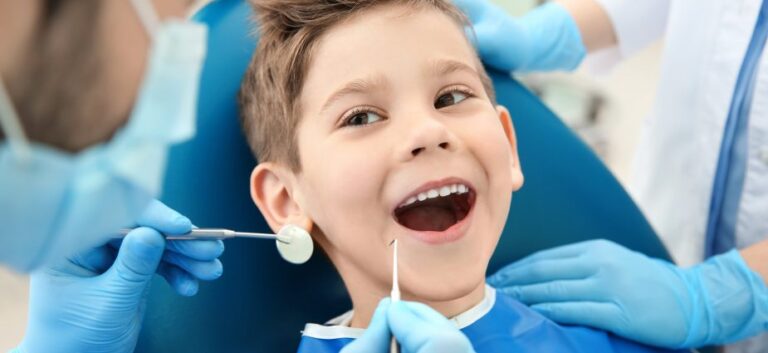
Answer: Your child should visit the dentist by their first birthday or when their first tooth appears, whichever comes first. Early dental visits help monitor oral development and establish good oral hygiene habits.
Answer: Children should visit the dentist every six months for a check-up and cleaning, just like adults. Regular visits help prevent cavities, monitor dental development, and teach kids the importance of oral hygiene..
Answer: To prevent cavities in children, encourage regular brushing with fluoride toothpaste, flossing daily, limiting sugary snacks and drinks, and scheduling regular dental check-ups. Dental sealants are also effective in protecting children’s teeth from decay.
Answer: You should begin brushing your child’s teeth as soon as the first tooth appears. Use a soft-bristled toothbrush and a small amount of fluoride toothpaste. Supervise brushing until your child can brush effectively on their own, usually around age 6 or 7.
Answer: Your child should use a soft-bristled toothbrush with a small head that fits comfortably in their mouth. For children under 3, use a smear of fluoride toothpaste. For those 3 and older, use a pea-sized amount.
Answer: Dental sealants are thin, protective coatings applied to the chewing surfaces of molars to prevent cavities. They are highly effective in reducing tooth decay in children and are recommended for kids once their permanent molars appear.
Answer: To soothe teething pain, gently rub your child’s gums with a clean finger or give them a teething ring. Cold, wet washcloths and over-the-counter pain relievers (as directed by your pediatrician) can also help alleviate discomfort.
Answer: Children typically start losing their baby teeth around age 6, with the front teeth falling out first. The process continues until around age 12, when all permanent teeth should have replaced the primary ones.
Answer: If your child knocks out a permanent tooth, try to place it back in the socket and visit the dentist immediately. If it’s a baby tooth, schedule a dental appointment to assess any damage. For both, keep the tooth moist in milk or saliva until you reach the dentist.
Answer: Tooth decay in children is caused by bacteria in the mouth that feed on sugars from food and drinks, producing acids that erode the enamel. Poor oral hygiene, frequent snacking, and sugary drinks increase the risk of cavities.
Answer: Yes, baby teeth are essential for proper speech development, chewing, and holding space for permanent teeth. Untreated decay in baby teeth can lead to infections, pain, and issues with permanent teeth alignment.
Answer: Start by making brushing and flossing a fun, consistent routine. Use child-friendly toothbrushes and flavored toothpaste, play brushing songs, and set a good example by brushing together. Reward your child for good oral hygiene habits to encourage consistency.
Answer: Fluoride treatments are often recommended for children to strengthen their tooth enamel and protect against cavities. Many children receive enough fluoride through toothpaste and drinking water, but your dentist may suggest treatments if needed.
Answer: Children should have their first orthodontic evaluation around age 7. Early detection of bite issues or misalignment allows for timely intervention, potentially reducing the need for more complex treatments later.
Answer: To protect your child’s teeth during sports, have them wear a custom-fitted mouthguard. Mouthguards help prevent dental injuries like chipped, broken, or knocked-out teeth, especially during contact sports.

